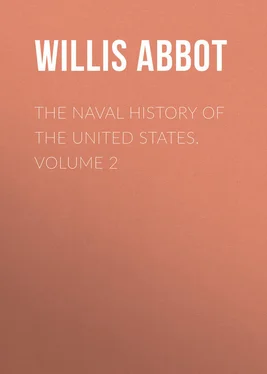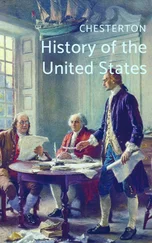Willis Abbot - The Naval History of the United States. Volume 2
Здесь есть возможность читать онлайн «Willis Abbot - The Naval History of the United States. Volume 2» — ознакомительный отрывок электронной книги совершенно бесплатно, а после прочтения отрывка купить полную версию. В некоторых случаях можно слушать аудио, скачать через торрент в формате fb2 и присутствует краткое содержание. Жанр: foreign_antique, foreign_prose, Историческая проза, на английском языке. Описание произведения, (предисловие) а так же отзывы посетителей доступны на портале библиотеки ЛибКат.
- Название:The Naval History of the United States. Volume 2
- Автор:
- Жанр:
- Год:неизвестен
- ISBN:нет данных
- Рейтинг книги:5 / 5. Голосов: 1
-
Избранное:Добавить в избранное
- Отзывы:
-
Ваша оценка:
- 100
- 1
- 2
- 3
- 4
- 5
The Naval History of the United States. Volume 2: краткое содержание, описание и аннотация
Предлагаем к чтению аннотацию, описание, краткое содержание или предисловие (зависит от того, что написал сам автор книги «The Naval History of the United States. Volume 2»). Если вы не нашли необходимую информацию о книге — напишите в комментариях, мы постараемся отыскать её.
The Naval History of the United States. Volume 2 — читать онлайн ознакомительный отрывок
Ниже представлен текст книги, разбитый по страницам. Система сохранения места последней прочитанной страницы, позволяет с удобством читать онлайн бесплатно книгу «The Naval History of the United States. Volume 2», без необходимости каждый раз заново искать на чём Вы остановились. Поставьте закладку, и сможете в любой момент перейти на страницу, на которой закончили чтение.
Интервал:
Закладка:
Willis J. Abbot
The Naval History of the United States. Volume 2
PART II
CHAPTER XII
With the capture of the "Chesapeake" in June, 1813, we abandoned our story of the naval events along the coast of the United States, to follow Capt. Porter and his daring seamen on their long cruise into far-off seas. But while the men of the "Essex" were capturing whalers in the Pacific, chastising insolent savages at Nookaheevah, and fighting a gallant but unsuccessful fight at Valparaiso, other blue-jackets were as gallantly serving their country nearer home. From Portsmouth to Charleston the coast was watched by British ships, and collisions between the enemies were of almost daily occurrence. In many of these actions great bravery was shown on both sides. Noticeably was this the case in the action between the cutter "Surveyor" and the British frigate "Narcissus," on the night of June 12. The "Surveyor," a little craft manned by a crew of fifteen men, and mounting six twelve-pound carronades, was lying in the York River near Chesapeake Bay. From the masthead of the "Narcissus," lying farther down the bay, the spars of the cutter could be seen above the tree-tops; and an expedition was fitted out for her capture. Fifty men, led by a veteran officer, attacked the little vessel in the darkness, but were met with a most determined resistance. The Americans could not use their carronades, but with their muskets they did much execution in the enemy's ranks. But they were finally overpowered, and the little cutter was towed down under the frigate's guns. The next day Mr. Travis, the American commander, received his sword which he had surrendered, with a letter from the British commander, in which he said, "Your gallant and desperate attempt to defend your vessel against more than double your number, on the night of the 12th inst., excited such admiration on the part of your opponents as I have seldom witnessed, and induced me to return you the sword you had so nobly used, in testimony of mine… In short, I am at a loss which to admire most, the previous arrangement on board the 'Surveyor,' or the determined manner in which her deck was disputed, inch by inch."
During the summer of 1813, the little gunboats, built in accordance with President Jefferson's plan for a coast guard of single-gun vessels, did a great deal of desultory fighting, which resulted in little or nothing. They were not very seaworthy craft, the heavy guns mounted amidships causing them to careen far over in even a sailor's "capfull" of wind. When they went into action, the first shot from the gun set the gunboat rocking so that further fire with any precision of aim was impossible. The larger gunboats carried sail enough to enable them to cruise about the coast, keeping off privateers and checking the marauding expeditions of the British. Many of the gunboats, however, were simply large gallies propelled with oars, and therefore confined in their operations to bays and inland waters. The chief scene of their operations was Chesapeake Bay.
This noble sheet of water had been, since the very opening of the year 1813, under the control of the British, who had gathered there their most powerful vessels under the command of Admiral Cockburn, whose name gained an unenviable notoriety for the atrocities committed by his forces upon the defenceless inhabitants of the shores of Chesapeake Bay. Marauding expeditions were continually sent from the fleet to search the adjacent country for supplies. When this method of securing provisions failed, Cockburn hit upon the plan of bringing his fleet within range of a village, and then commanding the inhabitants to supply his needs, under penalty of the instant bombardment of the town in case of refusal. Sometimes this expedient failed, as when Commodore Beresford, who was blockading the Delaware, called upon the people of Dover to supply him at once with "twenty-five large bullocks and a proportionate quantity of vegetables and hay." But the sturdy inhabitants refused, mustered the militia, dragged some old cannon down to the water-side, and, for lack of cannon-balls of their own, valiantly fired back those thrown by the British, which fitted the American ordnance exactly.
Soon after this occurrence, a large party from Cockburn's fleet landed at Havre de Grace, and, having driven away the few militia, captured and burned the town. Having accomplished this exploit, the marauders continued their way up the bay, and turning up into the Sassafras River ravaged the country on both sides of the little stream. After spreading distress far and wide over the beautiful country that borders Chesapeake Bay, the vandals returned to their ships, boasting that they had despoiled the Americans of at least seventy thousand dollars, and injured them to the amount of ten times that sum.
By June, 1813, the Americans saw that something must be done to check the merciless enemy who had thus revived the cruel vandalism, which had ceased to attend civilized warfare since the middle ages. A fleet of fifteen armed gallies was fitted out to attack the frigate of Cockburn's fleet that lay nearest to Norfolk. Urged forward by long sweeps, the gunboats bore down upon the frigate, which, taken by surprise, made so feeble and irregular a response that the Americans thought they saw victory within their grasp. The gunboats chose their distance, and opened a well-directed fire upon their huge enemy, that, like a hawk attacked by a crowd of sparrows, soon turned to fly. But at this moment the wind changed, enabling two frigates which were at anchor lower down the bay to come up to the aid of their consort. The American gunboats drew off slowly, firing as they departed.
This attack infused new energy into the British, and they at once began formidable preparations for an attack upon Norfolk. On the 20th of June they moved forward to the assault, – three seventy-four-gun ships, one sixty-four, four frigates, two sloops, and three transports. They were opposed by the American forces stationed on Craney Island, which commands the entrance to Norfolk Harbor. Here the Americans had thrown up earthworks, mounting two twenty-four, one eighteen, and four six pound cannon. To work this battery, one hundred sailors from the "Constellation," together with fifty marines, had been sent ashore. A large body of militia and a few soldiers of the regular army were also in camp upon the island.
The British set the 22d as the date for the attack; and on the morning of that day, fifteen large boats, filled with sailors, marines, and soldiers to the number of seven hundred, put off from the ships, and dashed toward the batteries. At the same time a larger force tried to move forward by land, but were driven back, to wait until their comrades in the boats should have stormed and silenced the American battery. But that battery was not to be silenced. After checking the advance of the British by land, the Americans waited coolly for the column of boats to come within point-blank range. On they came, bounding over the waves, led by the great barge "Centipede," fifty feet long, and crowded with men. The blue-jackets in the shore battery stood silently at their guns. Suddenly there arose a cry, "Now, boys, are you ready?" "All ready," was the response. "Then fire!" And the great guns hurled their loads of lead and iron into the advancing boats. The volley was a fearful one; but the British still came on doggedly, until the fire of the battery became too terrible to be endured. "The American sailors handled the great guns like rifles," said one of the British officers, speaking of the battle. Before this terrific fire, the advancing column was thrown into confusion. The boats, drifting upon each other, so crowded together that the oars-men could not make any headway. A huge round shot struck the "Centipede," passing through her diagonally, leaving death and wounds in its track. The shattered craft sunk, and was soon followed by four others. The order for retreat was given; and, leaving their dead and some wounded in the shattered barges that lay in the shallow water, the British fled to their ships. Midshipman Tatnall, who, many years later, served in the Confederate navy, waded out with several sailors, and, seizing the "Centipede," drew her ashore. He found several wounded men in her, – one a Frenchman, with both legs shot away. A small terrier dog lay whimpering in the bow. His master had brought him along for a run on shore, never once thinking of the possibility of the flower of the British navy being beaten back by the Americans.
Читать дальшеИнтервал:
Закладка:
Похожие книги на «The Naval History of the United States. Volume 2»
Представляем Вашему вниманию похожие книги на «The Naval History of the United States. Volume 2» списком для выбора. Мы отобрали схожую по названию и смыслу литературу в надежде предоставить читателям больше вариантов отыскать новые, интересные, ещё непрочитанные произведения.
Обсуждение, отзывы о книге «The Naval History of the United States. Volume 2» и просто собственные мнения читателей. Оставьте ваши комментарии, напишите, что Вы думаете о произведении, его смысле или главных героях. Укажите что конкретно понравилось, а что нет, и почему Вы так считаете.











![Hubert Bancroft - The Native Races [of the Pacific states], Volume 5, Primitive History](/books/749157/hubert-bancroft-the-native-races-of-the-pacific-s-thumb.webp)
![Hubert Bancroft - The Native Races [of the Pacific states], Volume 1, Wild Tribes](/books/750126/hubert-bancroft-the-native-races-of-the-pacific-s-thumb.webp)